Steven Pressfield's Blog, page 62
March 8, 2017
“So long, David … “
We lost a valued member of our online community this past week—David Y.B. Kaufmann of New Orleans and Houston passed away after a two-year battle with cancer. If you’ve read the Comments section of this blog, you know David. His contributions were always keen and insightful, and pretty funny too. He was also a damn good writer. His series, The Scotch & Herring Mysteries, was original, smart, and one-of-a-kind. He leaves seven children, his wife Nechama, and a round of grandchildren on the way. We send our deepest condolences to all the Kaufmann family. We’re all one good guy poorer today.
In honor of David, whose mind had a definite metaphysical bent, let’s point today’s post on the Professional Mindset in a mystical direction.
We’ve said so far in this series that the writer, if she aims to be a professional, must think of herself as an entrepreneur.
She can’t look to anyone else to support her financially, emotionally, or creatively. She and she alone must take responsibility for her enterprise as an artist. She will manage her time and her emotions. She will generate her ideas. She will hold herself accountable.
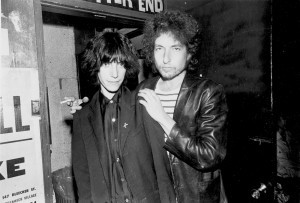
Patti and Bob back in the day (actually ’75, when they first met)
She will be as mentally tough as the most self-reliant entrepreneurs and as organized and orderly as Google or Apple or General Dynamics.
We also borrowed a concept from Dan Sullivan of Strategic Coach—his idea of “Unique Ability.” In writing terms, Unique Ability meant, we said, that voice, style, point of view, and storytelling gift that was ours alone, that no one else on the planet could duplicate.
All well and good.
But now, knowing all this and having successfully internalized it, we find ourselves drifting into terra incognita. We approach the threshold of the mystery.
The question becomes, “What is our unique ability? How do we find it? And what does it mean once we do find it?”
Here’s what I believe:
The source of our voice as writers (our unique ability) lies beyond our conscious mind.
You don’t know yours, and I don’t know mine.
But it knows us.
It knows us better than we know ourselves.
Our life’s work is to find it, to open the channel to this mysterious dimension. We teach ourselves to shuttle from the conscious to the unconscious, from the knowable to the unknowable, from the material to the divine.
Did Bob Dylan, when he was playing folk songs at the Bitter End in Greenwich Village in 1961, know that he would one day “go electric?”
Did he know he would have a “Christian phase?”
Did he reckon that he would pass from writing
How many ears must one man have
Before he can hear people cry
to
I used to care but
things have changed.
Did he possess the slightest clue that he would one day have not one hit album but two in a row, singing American standards?
I don’t think he knew any of it.
I don’t believe any of us do.
People say that writing is a form of self-expression. I don’t believe it. Writing is a form a self-discovery.
I don’t think any of us have any idea at all what we’re doing.
Our Muse leads us.
What you and I are doing as artists is apprenticing ourselves to a part of our psyche whose contents we can never know and whose purpose we can never divine, a sector of our consciousness that knows us intimately, that carries our daimon and our voice, but that only reveals itself to us in snatches, speaking, like dreams, in symbols and riddles.
But wait, you say. How does all this mumbo-jumbo jibe with the idea of the entrepreneurial ethic, of the Professional Mindset?
Entrepreneurs have muses too. Steve Jobs did. Elon Musk. Sergey Brin.
They are being led, just like you and me, from project to project, from inspiration to inspiration.
The Professional Mindset does not lose its utility when you and I enter the Extraordinary World. It changes, that’s all.
Instead of focusing on time management, say, or acquiring the art of saying no, the Professional Mindset shifts gears and tunes in, with a patient and keenly attentive ear, to the Cosmic Radio Station.
Part of the Professional Mindset releases all inhibition, so that it can receive whatever assignment its muse presents to it next. While part of it remains grounded in Realityville, reminding itself, “Damn, this is great sh*t! I better get it down in my notebook before I forget it!”
So long, David. Thanks for being part of our gang and our metaphysical quest. We will not forget you.
March 3, 2017
Be More Than A Milk Crate
Last month I attended the man of the year ceremony hosted by the Optimist Club of Passaic, New Jersey.
As the man of the year (also my husband’s cousin) stood up to speak, I was struck by the 400+ people in the room who’d shown up for the event. The cousin didn’t have a web site. He didn’t have a product to sell. He didn’t market himself via social media. Instead, he got out into the community and volunteered.
He’s a teacher who has coached football, headed the school’s ski club, worked with special education kids, raised money for scholarships, opened his home to friends and family in need, and who raised his 12 year old sister after their mother died and he became the sole caregiver (though he was barely 20 years old himself at the time).
People got to know him because he put himself out there.
He was seen.
People like him because he always has something kind to say (and his charm and quick wit are hard to deny).
He’s a good guy.
People show up when he needs help and to honor him because he shows up for them.
He gives back to others.
We spend so much time on this site—and other sites—talking about web sites and Google Analytics, and building engaging content and permission-based relationships, and blah, blah, blah.
If you really want someone to show up for you to support your work, you’ve also got to put in some face time.
Get out of your chair.
Leave your house.
Say hello to the rest of the world.
Build relationships that aren’t based online.
Do good for others.
Anyone can jump atop a milk crate in London’s Speaker’s Corner. But as they walk off, only a few have followers who trail after them—and fewer have followers who take action, who do more than follow like sheep.
Be more than a milk crate—and build more than a platform.
March 1, 2017
A Map of the Unknown World
[Continuing our series on the Professional Mindset … ]
I’m reading a great book now (thanks, Bill Wickham, for turning me onto it) called Bugles and a Tiger, My Life in the Gurkhas by John Masters.
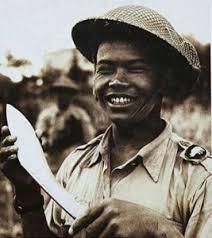
A WWII Gurkha with famous kukri knife
This is the kind of book I absolutely devour—a straight-ahead memoir, no plot, no characters, just an absolutely true account of a fascinating life experience, in this case the tale of a young Brit who served in India in the 30s in a legendary Gurkha battalion.
What exactly is a Gurkha?
The Gurkhas are Nepalese peasantry. Modest of stature, often illiterate, incredibly hardy and brave, loyal, dedicated and true, they have covered themselves with glory in every war they’ve fought in.
Here’s a story from Bugles and a Tiger (trust me, this relates back to writing and to the Professional Mindset):
A Gurkha rifleman escaped from a Japanese prison in south Burma and walked six hundred miles alone through the jungles to freedom. The journey took him five months, but he never asked the way and he never lost the way. For one thing he could not speak Burmese and for another he regarded all Burmese as traitors. He used a map and when he reached India he showed it to the Intelligence officers, who wanted to know all about his odyssey. Marked in pencil were all the turns he had taken, all the roads and trail forks he had passed, all the rivers he had crossed. It had served him well, that map. The Intelligence officers did not find it so useful. It was a street map of London.
I can relate to this saga completely. I have written entire books (The Legend of Bagger Vance for one) where I was navigating with total confidence by a map in my head, only to realize later that the map bore no relation whatsoever to the ground I was marching over. Yet I made it home.
I’ll bet you’ve done it too.
Our Gurkha rifleman had no legitimate map, but he had something better.
He had a professional mindset.
He had confidence.
He had self-commitment.
He had faith.
He knew the sun rose in the East and he knew he was heading northwest. He knew to keep his own counsel, trust no one but his own inner guide, and to keep on trucking.
Who cares if there was no Hammersmith or Wimbledon in the Burmese jungle? There was the stream, there was the crossroads. “You gotta believe.”

Prince Harry visits the contemporary Gurkhas, 2016
In the end, you and I as writers are guided in our work less by the specifics of our self-designs or structural concepts (however helpful such systems might be) and more by a calling in our hearts.
The story we’re telling knows itself.
It knows where it’s going.
It’ll tell us if we listen.
Our Gurkha rifleman may not have been able to spell Shepherd’s Bush or King’s Cross. But he knew his heart.
He knew his way home.
February 24, 2017
Grace Under Pressure
I’m at the laundromat in Montana doing the midweek vacation clothes. Will be back in the saddle next week. Thought I’d run a personal favorite post of mine from back in the fall of 2015.
Why can some surgeons, poker players, mountaineers, fashion designers, athletes and even writers tune out the external noise—and the even more distracting internal chatter—and perform seemingly effortlessly under extraordinary pressure?
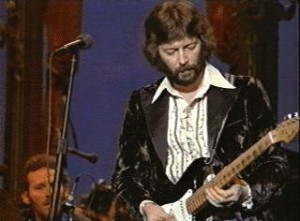
Eric Clapton playing in The Last Waltz
While others with comparable training and technique, while capable and competent, just can’t approach the holy moly level of a transcendent master?
Here’s an example of one such performance I watched with awe and joy almost forty years ago (and still do today)…
By Thanksgiving November 25, 1976, Farther Up the Road, then a twenty-year-old, mid-tempo, twelve-bar, Texas blues shuffle originally recorded on Memphis’s Duke records by Robert Calvin Brooks (aka Bobby “Blue” Bland) was a Rock & Roll standard.
Written by Joe Medwick Veasey and Don Robey, it was, and still is, one of those old reliables—a crowd pleaser that any bar band looking to fill out a set can learn quickly. The song’s genre structure is titanium solid, which makes it difficult for a musician to get “lost.” And even if a player does get lost, it’s not too hard for him to get back in the groove. It has the kind of form that opens up a lot of room to play around in too, to improvise—not dissimilar to some of fiction or nonfiction’s traditional writing genres. Like a “meet cute” love story or an extended obituary.
At around 9:00 p.m. that night at the Winterland Ballroom in San Francisco, after a select group of 5,000 or so invited guests were full of turkey and Asti Spumante and after they’d exhaled enough odiferous smoke to fill the rafters of the historical 1928 ballroom/ice skating rink, the impresario Bill Graham had the dancefloor chandeliers outed.
A familiar voice came over the blackness. It was the voice of the heart and soul of The Band…Levon Helm.
“Good evening.”
Still cameras clicked and flashed, momentarily revealing the baroque stage and the five players upon it. And then an opening drum lick…boom, boom, boom…chit-chit, the opening to the Louisiana gumbo rooted classic “Up on Cripple Creek.”
Cinematographer Michael Chapman and his camera crew filmed drummer Levon Helm, pianist Richard Manuel, bassist Rick Danko, organ/keyboards/saxophonist Garth Hudson and lead guitarist Robbie Robertson from the stage…on the fly…a technique that gives the viewer a feel for what the reality of being a Rock & Roll star is all about. Not just in 1976, but for all time.
All of the exhilaration, but more importantly the absolute terror of facing an audience with huge expectations…
The concert footage would become part of Director Martin Scorsese’s The Last Waltz, his groundbreaking documentary about the end of the road for a group of guys burned out living their dreams.
The movie begins with the story’s controlling idea.
We hear an off screen Scorsese setting up a manufactured bit with Rick Danko at a pool table (a shot that Scorsese would play with again a decade later in The Color of Money). This is a daring choice not to hide the artifice of constructing the documentary’s Story. How the director cues the seeming off-handed commentary etc. pulled down the traditional documentary curtain.
I think the choice lends ever more veritas and gravitas to the work. It’s as if Scorsese is saying “we’ll show you the bullshit behind the Story so that you’ll understand the truth of the music…which you just can’t bullshit on stage.”
Back to the controlling idea.
We hear Scorsese ask Danko, “Okay Rick, what’s the game?”
Danko: “Cut throat.”
Scorsese: “What’s the object of it?”
Danko: “Object is to keep your balls on the table, and knock everybody else’s off.”
And then we get the foreshadowing of the encore from the actual show (“Don’t do it”) which rolls into the opening credits which then sets up an interview with the movie’s central ego Robbie Robertson explaining what we’re about to see…
As inciting incident sequences go…you can’t really do much better than that.
The Last Waltz is so perfect that it was only a matter of time before it was parodied. Rob Reiner’s mockumentary This is Spinal Tap was the hilarious result. Reiner takes the Scorsese on-screen role in Spinal Tap as “Marty Di Bergi” intent on tracking the meaning of the careers of David St. Hubbins, Derek Smalls, and Nigel Tufnel. It’s the yin to The Last Waltz yang, played perfectly straight.
The middle build of Scorsese’s movie is to reveal just how accomplished The Band was as a musical force. To do that, a who’s who list of superstar performers come on stage from a wide variety of genres—Joni Mitchell to Dr. John to The Staples Singers. They’re all backed by the stellar quintet.
Which brings me to the moment when the transcendent master arrives.
It’s just after Muddy Waters performance, about one hour fifteen minutes into the film, which runs about two hours long total.
If I were storygridding The Last Waltz, I’d identify this moment as the ending climax of the middle build. The ending payoff is the arrival of Bob Dylan, which didn’t come close for me to the level of energy and excitement from this moment. But The Band backed Dylan when he went electric, so it makes sense to make him the big closer…even if his performance is somewhat disappointing. Which is probably what he was going for anyway.
Just as Muddy Waters walks off the stage to well-deserved thunderous applause, Robbie Robertson asks a rhetorical question and soon thereafter answers it.
Play guitar? Eric Clapton?
Eric Clapton is 31 in 1976.
He’d been called God a decade earlier and he’s been in some of the biggest super groups of the 60s and 70s. But when he comes on screen in The Last Waltz, he just seems kind of “over it.”
He’s said in the press and in interviews prior to the concert that he credits The Band with giving him a finer appreciation of songwriting and craftsmanship (Layla was one such response to Music from Big Pink), so his appearance on stage makes sense. But his body language suggests he’s not all that into being “on” tonight and he’d just as soon get it over with.
There’s a brief discussion that we the viewers can’t hear that goes on between Clapton and Robertson, which is probably just confirming their trade off of bits they’ll do for the song they’ve chosen beforehand, Farther on Up the Road. Again, Scorsese and Michael Chapman give us a completely unique view of the action…from behind Levon Helms’ drum kit so we see and can almost “feel” the want and need washing over the players from the audience.
DON’T DISAPPOINT US! MAKE THIS ONE OF THE GREATEST NIGHTS OF OUR LIVES!
Clapton kicks off the song with an impeccable intro, but as is his custom, after a visual check or two with Robertson, he proceeds to go into himself, closing and opening his eyes while watching his fingers fret. He’s have a dialogue with himself, one it seems he’s had numerous times before.
And then something absolutely wonderful happens.
Just as he’s finishing up the intro and about to go into the first line of the song, thirty eight seconds in, Clapton’s guitar strap breaks. For some reason before he went on stage, he put it on with a loop, kind of willy-nilly. So with the last slight pull downward from the neck of the guitar emphasizing the final note before he has to start singing, the strap gives and his guitar starts to fall.
With more irritation than panic, Clapton just shouts out “Rob!”
Robertson sees what’s happened as has every other member of the band…remarkably. There is a microsecond of a hitch and then…back to the beginning of the twelve bars with Robertson playing lead guitar as Clapton fixes his strap.
Robertson takes the level up a notch. He plays with a much more of a pressing quality, and for lack of a better description a “blangie” kind of reverb…sort of a traditional rock guitarist sound.
Clapton comes back and settles into his natural groove…just a clean, effortless sort of cool. He doesn’t seem to have to grind out anything. Slow hand, just another of his nicknames, knows what to keep out and what to slide into every single lick.
We can intuit all of this stuff because Chapman is filming Robertson as he watches Clapton play. His look seems to contain a mixture of awe and what could be interpreted as anger.
Next we get Clapton’s super cool voice singing the first two verses while a whole slew of roadies watch him from back stage:
Farther on up the road,
Someone’s gonna hurt you like you hurt me
Farther on up the road,
Someone’s gonna hurt you like you hurt me
Farther on up the road,
Baby, just you wait and see
You’re gonna reap just what you sow
That old saying is true
You’re gonna reap just what you sow
That old saying is true
Just like you mistreat someone, someone’s gonna mistreat you.
And then Clapton gives us what we expect to hear from him. A blistering solo that is as impeccable a demonstration of control as it is virtuosity. Speed that feels like molasses…purity of intention and sound.
But what’s this?
Just as Clapton finishes, Robertson runs up to take the lead. He seems to have even played a little over ECs final notes… It’s as if Robertson isn’t going to just sit back and watch Mr. Perfect eat off of his plate. He’s going to show the crowd that he’s not some slouch. He’s a lead guitarist too.
The camera shot includes Rick Danko banging out his baseline behind Robertson as he floors it down the neck of his guitar, pulling out every wild rockabilly run he’s ever played or heard in his life, but doing it with a speed that is surely unsustainable. Danko perks up with a bit of a smirk knowing that there is no way the Robertson will be able to maintain his pace.
Then the camera cuts to EC’s reaction. Which is pure joy!
He’s in the moment now, having actual fun, and he’s loving Robertson’s balls to the wall throw down. Robertson is killing it and Clapton is smiling for the first time since he’s walked on stage.
Cut to Levon Helm who has leaned into his kit with the excitement of a surfer riding a wave into a perfectly forming tube.
Back to the two shot of Robertson and Danko, who isn’t smirking anymore. He’s rooting on his bandmate to bring the solo home. And he does.
Robertson somehow pulls it off and the crowd seems stunned…like what’s going on? I thought Clapton was going to rock us?
Clapton then steps into the mike to pick up the vocal.
Farther on up the road,
Someone’s gonna hurt you like you hurt me
Farther on up the road,
Someone’s gonna hurt you like you hurt me
Farther on up the road,
Baby, just you wait and see
You’ve been laughing pretty baby,
Someday you’re gonna be crying,
You’ve been laughing pretty baby,
Someday you’re gonna be crying,
Farther on up the road,
You’ll find out I wasn’t lying.
And then the time arrives for Clapton to respond.
He channels the mysterious force. It’s the force that can only be unleashed by the very few. Only those capable of monstrous dedication to craft who also have the courage to forget about the craft under the greatest possible pressure will pull it off.
The speed with which Clapton hits his notes is impossible to convey. But it’s the incredible sense of control and specificity of sound that is truly remarkable. He’s playing several times faster than Robertson, but at no point does it seem as if he is “pushing it.” No one’s worried, he’s not going to go fumble.
When he’s finished the last note and the applause waves over the stage—Danko, Robertson and Helm look like they’ve been on a spaceship that’s gone to Mars and back—Clapton seems as stunned as the rest.
The guy who seemed to reluctantly agree to play just as a favor for some friends doesn’t want to leave the stage.
To get to that place is where we really all want to go.
February 22, 2017
Frank Sinatra Does Not Move Pianos
I’ve quoted Dan Sullivan before and I’m gonna do it again. Do you know him? He’s the founder and CEO of Strategic Coach and one of the great mentors to entrepreneurs in the world. So, in keeping with this series on the Professional Mindset, let me rip off a few more of his ideas for you. (Thanks, Dan!)
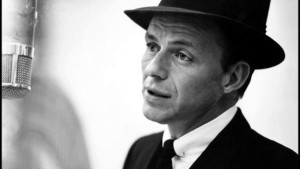
Frank Sinatra sings … and he prepares to sing. Nothing else.
Dan tells the story that when he was in the army stationed in Korea, one of his jobs was putting together shows for the troops. Frank Sinatra came over one time. Dan studied him carefully and, as he says,
One of the things I learned was that Frank Sinatra does not move pianos.
Frank has other guys who do that. Frank does only two things, Dan says.
Frank Sinatra sings, and he prepares to sing. That’s it.
Dan has a concept he calls “Unique Ability.” This, he explains, is the entrepreneur’s gift. It’s her singular talent, the one thing that she brings to her business that nobody else can bring.
Steve Jobs had a Unique Ability.
Seth Godin has it.
Shawn has it.
You have it too. In many ways your job as a writer or an artist is to find out what your unique ability is and then organize your day, your month, and your year in such a way that you maximize your time exercising your unique ability and minimize or outsource everything else.
When I was in Israel researching The Lion’s Gate, I interviewed a number of people who had been close to Moshe Dayan, the great Israeli general and Minister of Defense. I heard over and over that Dayan used to say, “I don’t want to do anything that somebody else can do.”
In other words, Dayan brought something unique to the table. No doubt it was hard to define. It was an intangible. Vision, perhaps. Charisma. Whatever it was, he understood it and so did everyone around him.
His soldiers did not want Moshe Dayan to move pianos. If he tried to move a piano, his officers would have tackled him and dragged him off the stage. They wanted Dayan to command, to do what he could do that nobody else could do.
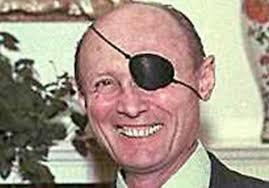
Moshe Dayan
Dan Sullivan, when he speaks of unique ability, is not thinking specifically of writers or artists, he’s thinking of entrepreneurs. He’s thinking of Larry Ellison or Sergey Brin or Steve Jobs. But the concept applies, I believe, more to writers and artists than to anybody.
Stephen King has Unique Ability.
So does Toni Morrison.
And Tom Wolfe and Harper Lee and J.D. Salinger.
Each of them brings something to the party that nobody else can bring.
I read somewhere that we all should find that one thing that we can do better than anyone else in the world. When I first heard that, I thought, “That’s a bit grandiose, isn’t it? What could we possibly do that fifty thousand other people couldn’t do better?”
But I was wrong.
I have something, maybe more than one thing, that I can do better than anyone else in the world. So does my friend Randy and my friend Victoria. So do you.
My friend Mike just showed me a manuscript he’s been working on for five years. The pile of pages was a foot high. Mike’s book had created an entire world, down to the most minute details. He was, in the arena he had envisioned and brought to life, the best in the world. He was Frank Sinatra.
As writers and artists, our unique ability is our voice. Our peculiar, idiosyncratic point of view. Our sense of humor, our sense of irony, our one of a kind vision of the world.
Don’t feel bad if you’re twenty years old or forty years old and you’re saying to yourself, “I don’t know what my unique voice is.”
The truth is we don’t know what our voice is until we sing once, and sing again, and sing again and again.
I’ve said before that I had no idea what books would come out of me until they came, and when they did, I was more surprised by them than anybody.
Our voice is there already.
We were born with it.
Our Muse knows it, even if we (so far) don’t.
We reveal it to ourselves and to the world through work. By following our creative heart and seeing what comes out.
The Professional Mindset is about NOT moving pianos. It’s about finding that unique voice that is ours alone.
Frank Sinatra sings, and he prepares to sing.
That’s it.
February 17, 2017
Getting Past No
 (This post went up almost 3.5 years ago. Bringing it back for a rerun today.)
(This post went up almost 3.5 years ago. Bringing it back for a rerun today.)
I started this post Wednesday.
Thursday I read this from Seth Godin:
What “no” means
I’m too busy
I don’t trust you
This isn’t on my list
My boss won’t let me
I’m afraid of moving this forward
I’m not the person you think I am
I don’t have the resources you think I do
I’m not the kind of person that does things like this
I don’t want to open the door to a long-term engagement
Thinking about this will cause me to think about other things I just don’t want to deal with
What it doesn’t mean:
I see the world the way you do, I’ve carefully considered every element of this proposal and understand it as well as you do and I hate it and I hate you.
Thursday afternoon, Jonathan Fields’ “When No Means Go” arrived in my in box.
Seems a few of us have no on the mind this week.
As the third one in the ring . . . It’s the reaction to no that’s been on my mind.
A few years ago, a dying car sent me into a car dealership for a new set of wheels. While filling out the financial forms, the car salesman asked about my work.
“Publishing,” I replied.
“Oh, I have a manuscript. I’ll bring it in tomorrow when you pick up the car.”
I smiled politely and asked if I had signed all the right boxes.
Guess who drove her husband’s car to the dealership and then sped off after he went inside and picked up the new car. . . .
“Why didn’t you tell him no?” my husband asked.
“I didn’t want to hurt his feelings.”
“Isn’t it worse to lead him on and then not show up?”
“I didn’t lead him on. I didn’t say yes.”
“You didn’t say no, either.”
I’ve always had a hard time saying no.
1) I like helping friends, family, colleagues, causes . . .
2) I don’t like dealing with the response to no.
Jonathan’s piece does a great job of explaining his reasons for saying no, so I won’t go into them here. Read his post and know that bandwidth is in my vocabulary, too.
Instead . . . That reaction to no . . .
Earlier this year, I was told no in response to a project on which I’d been working. I’ve been told no before. Who hasn’t? However . . . The way this one arrived was a first.
My response ran like Elisabeth Kubler-Ross’ five stages of grief, except without “bargaining” and repeat visits from “Denial” and “Anger.” I understand the no now, but at the time . . . I couldn’t get my head around the emotions. During the release of The Authentic Swing, when I responded with a few no’s myself, I got it.
With the release of The Authentic Swing, a number of readers assumed Steve was doing interviews. That’s what you do when you release a book, right? You do interviews. . . That’s not what the Black Irish team did, though. (read “Portrait of a Launch”)
And then Steve’s interview with Oprah followed, which buttressed the Steve’s-doing-interviews-now thinking—and I responded with more no’s and explained that the interview with Oprah wasn’t about launching a new book. The close timing for the launch of the book and the interview was a coincidence.
Around that time, Glenn Reynolds‘ producer contacted us about Glenn visiting Los Angeles. Would Steve have time to meet up? Glenn has interviewed Steve in the past, but they’ve never met in person. Yes, he replied and Glenn’s producer and I booked the interview.
Earlier in the year, Aubrey Marcus reached out to share his work with Joe Rogan and the possibility of scheduling an interview. Joe’s also located in the Los Angeles area, soo . . . If Steve was breaking for one interview. Would he do two, if we could book them close together? He did, a day apart, enjoying both, and then went back to work.
More requests came in—and I understood why. For the most part, those told no understood, but . . .
I read a post from someone who had been told no. He made a comment on his site, along the lines of (I’m paraphrasing here): “Pressfield’s booking person declined an interview with me a while back and, at the time, I bet that if Oprah called, he wouldn’t say no to her. Well . . Guess who did an interview with Oprah?” Then he went on to say he receives books from other authors every day who are interested in working with him and he’ll support them instead . . . (again, paraphrasing, based on my interpretation and memory . . . )
It was painful to read because I understood where he was coming from.
No feels like a personal rejection. He made the no about him. And then he made Steve’s yes to Oprah about him, too. Those answers weren’t about him. They were about Steve, his time, and his work.
Back to that post from Seth, which started this article, on what no doesn’t mean:
What it doesn’t mean:
I see the world the way you do, I’ve carefully considered every element of this proposal and understand it as well as you do and I hate it and I hate you.
It’s easier to write this than it is to put it into practice, but . . .
You have to move beyond no. If you don’t, it will devour you from the inside out.
For those saying no: You don’t owe anyone anything, but . . . be nice. Think about how you would want to be told no yourself.
In Steve’s case, he’s aware that people want him to say yes, which is one reason the “Ask Me Anything” audio series was launched. It’s an opportunity for Steve to connect with readers and answer their questions, but on his time. He’s done one hour-long session so far, with more to come. When I respond no on Steve’s behalf, or for other clients, or my own personal projects, I try to make the no’s shared as nicely as possible, thinking about how I’d want to receive them myself. I believe in the boomerang of Karma. What goes around comes around.
For those receiving a no: It hurts, yes, but . . . Back to that list above from Seth. More often than not, no is not about you. George Costanza might have used that old “It’s not you, it’s me” line to get out of things, but . . . In the real world, often no really isn’t about you. Move on with your art. Let it inspire you instead of being an anchor, weighing you down.
February 15, 2017
Your Resistance and Mine
This is the fourth post in our series called “The Professional Mindset.” Let’s pause here and flash back to what this stuff is all about.
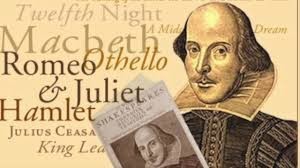
Yep, he battled it too.
It’s about Resistance.
We adopt the Professional Mindset for one reason only: to combat our own internal self-sabotage.
The professional mindset is a weapon against Resistance, like AA is a weapon against alcoholism.
Don’t laugh. The analogy is exact.
Have you, the writer, ever woken up metaphorically face-down in the gutter at five in the morning with an empty bottle beside you?
I have.
Have you ever said to yourself, “I am powerless against this force that is destroying me from inside?”
I have.
Have you ever said to yourself, “I don’t know how I’m going to do it, but I’m going to turn my life around, starting right here and right now.”
Some people might call that moment “hitting bottom.”
I call it “turning pro.”
I call it switching to the Professional Mindset.
In Twelve Step programs the first action you take is to admit you are beaten. You acknowledge that a certain internally-generated negative force has power over you. It has defeated you over and over in the past, and it’s going to destroy you completely if you can’t get a handle somehow on facing it and containing it.
As writers and artists, we wake up with that negative force every morning.
It never goes away.
It never gets any easier.
We are exactly like recovering alcoholics.
Our booze is Resistance.
It tempts us every day, every hour. It’s seductive, it’s diabolical, it’s indefatigable.
In Twelve Step programs, the individual’s mantra is “One Day at a Time.”
That’s my mantra too.
I don’t go to meetings like individuals in AA or Al-Anon or other Twelve Step programs.
These blog posts are my meetings.
I reinforce myself with them. I screw up my courage by sharing my losses and victories on the page, on the web.
The principles involved are the same.
Humility.
Acceptance of vulnerability.
Resolve to prevail.
The Professional Mindset, in whatever form you or I adopt it, is the most powerful weapon I’ve ever heard of in the battle against Resistance and self-sabotage.
We spoke last week (the post was titled “You, Inc.”) about thinking of ourselves not as individuals but as enterprises. That’s a mind trick. It’s a head game. But it works, just like Twelve Step programs work.
To think of ourselves as professionals (as opposed to amateurs) eliminates self-judgment and self-condemnation, both of which are weapons that our own Resistance uses against us.
There’s nothing wrong with you if you wake up every morning with that dragon in your head.
Sappho woke up that way.
Dostoevsky woke up that way.
Shakespeare woke up that way.
They all experienced a moment when they said to themselves, “I accept this as my internal reality. From this day forward, I will organize my inner resources not to yield to this negative force but to face it and overcome it.”
Repeat after me:
“My name is ____________ and I have been defeated by Resistance.”
Now we can begin.
February 10, 2017
Love Story Cheat Sheet/Conventions
At long last, we’ve come to the end of this romantic journey.
I’ve been compiling a category-by-category cheat sheet for the must-haves of any working love story. To read the series from end to end, here are the previous five posts—1, 2, 3, 4, and 5.
The final topic to cover is the conventions of love story.
Conventions differ from obligatory scenes in that they are not formalized beginning, middle and end units of story. Instead they are the milieu of a particular content genre, distinct add-on elements that give the story context, which elicits an emotional response from the reader/viewer.
A convention for a lawn mower is to have a pull cord to get the engine started. You can certainly change that convention to an on/off switch, but whatever choice you make to abide the convention (a force is necessary to begin a chain reaction) you’ll need something to get the engine started. Or you’ll have little chance of cutting the yard.
So conventions evolve over time—like a pull cord to an on/off switch. Some are added and some discarded from a content genre depending upon the cultural context.
Readers intuitively expect them to be present without formally checking that they are. That is, they don’t know that they’re supposed to be there. They just know something’s off when they’re not. The story just doesn’t “feel” right. They don’t emotionally connect to it in the way they’d anticipated.
In Donald Rumsfeld-ian terms, the conventions are UNKNOWN KNOWNS.
Conventions of a particular content genre are key to delivering the emotional experience a reader is expecting from the genre itself.
One love story convention that’s been shape shifting since it’s introduction back in the days of Chivalry is the necessity for clearly defined gender roles…traditional female and male characteristics played by the male and female players, respectively.
Now the two players can have both the traditional male (emotionally guarded and more obsessed with consummating the relationship than connecting emotionally) and traditional female (looking for a deeper connection before physical connection) sensibilities.
There’s a terrific series on Netflix called “LOVE” that plays with the convention very well. The man is more “female” and the female is more “male.” It’s perfectly in tune with our culture today.
That great movie BROKEBACK MOUNTAIN does a terrific job abiding the convention too. Even though the love story is between two men, there are distinct gender roles played. Watch it again and see if you can pinpoint what I mean.
Conventions are the ways in which storytellers deliver emotional experiences to their readers. They are the means to the ending emotional effect. So to best understand convention we need to examine what emotional experience a particular story genre promises.
Crime stories concern justice as their core value and the core emotion is intrigue. We become fascinated with discovering the how, who, what, where and why of the fictional crime as we follow an investigator from beginning to middle to end. And that emotional experience, intrigue, keeps us coming back for more and more.
Similarly, action stories, which revolve around the life/death value, deliver excitement as their emotional experience. Excitement is best described as the “tiger in a cage” phenomenon. We witness a very dangerous thing but from the safety of having it confined at a safe distance. We won’t get bitten, but we can watch the tiger bite something else inside the cage.
This is a similar emotional experience we get from love stories.
We get to fall in love when we read or watch a love story and experience all of the sturm and drang of love…but at a safe distance. We don’t actually have to put ourselves in any vulnerable position. We get to vicariously experience love without risk.
How great is that?
For some people that’s the only kind of love they’re interested in.
Why do you think 200,000,000 units of love story are sold every year (that’s 500,000 copies every single day!)?
Love story makes up 45% of Amazon.com’s entire book market.
Check out this incredible presentation from “Data Guy,” to see the hidden sales details of the dominant story of our time (and probably of all time!).
We experience the feeling of romance when we enjoy a love story, the butterfly in the stomach churn when we are attracted to another person.
So how do writers ensure that they deliver this emotional catharsis?
By making sure they have these ten elements in their love stories, they’ll give the reader the best possible environment to fall in love with their lead characters. It’s incredibly effective. Literary alchemy.
The Rival: There must be a competing force for the affections of one or both characters. Without rivals, there is no possibility for Crisis (if there is no alternative choice how do you have a best bad one? or an irreconcilable good one?) Sometimes a Rival isn’t flesh and blood. Check out Alfred Hitchcock’s NOTORIOUS. One major Rival for Ingrid Bergman’s affections is her dependence on booze. Will she choose booze or Cary Grant? Which brings up another major convention of the love story.
Moral Weight: This is the baked in INTERNAL GENRE to the best love stories. The idea is this… If the lovers cannot elevate themselves morally, they will not be able to find authentic love. That is, they must have a worldview shift that raises their moral fiber. In Pride and Prejudice, you guessed it, if the two central lovers do not overcome their pride and prejudice, they won’t be able to properly love one another. This is why the book works so well. It clearly tells us that Love requires self-reflection and change. Sweet talk and roses mean nothing without moral elevation.
Helpers: There are those in favor of the love match who help the two come together.
Hinderers: There are those who are not in favor of the love match who work to destroy the match.
Gender Divide: Distinct differences in the ways the two lovers view love and its responsibilities must be in play.
External Need: One or both of the lovers have to have external pressures on them to find a mate quickly. There’s a great movie called A NEW LEAF with Walter Matthew and Elaine May. A perfect example of external need. P and P is perfect too.
Forces at Play Beyond the Couple’s Control: Social convention often fits the bill here. The woman, or the man, is from the other side of the tracks…
Forces at Play In the Couple’s Control: This usually goes hand in hand with the moral weight convention. One or both of the lovers has to get out of their own way and change their behavior and worldview before they’ll be rewarded with authentic love.
Rituals: The lovers develop little things that they only do with one another. In P and P Elizabeth and Darcy only tease one another…they don’t do that to any other character in the story. In The Apartment Jack Lemmon and Shirley MacLaine play gin rummy
And last but not least, there must be
Secrets: There are four varieties, a.) Secrets society keeps from the couple, b.) Secrets the couple keeps from society, c.) Secrets the couple keeps from one another d.) Secrets one of the couple keeps from himself/herself.
Not delivering conventions with innovative verve will alienate your audience. It will make them feel as if something was missing in the telling (Unknown Knowns) and for that very reason the story will not satisfy their expectations.
They just won’t get the emotional oomph they’d hoped for when they gave your story a chance. And we all know what happens when a story fails to meet expectations…it does not spread.
Take the time to work up some dazzling satisfactions of these conventions…and you’ll find that you’ll be well on your way to solving the rest of the riddles of your global love story.
February 8, 2017
You, Inc.
[This is Post #3 in our new series, “The Professional Mindset.”]
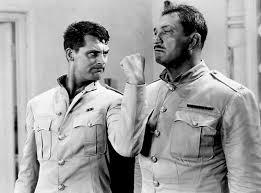
Cary Grant and Victor McLaglen in “Gunga Din.”
I had a friend named Victoria when I was working in Hollywood. Victoria was a successful screenwriter, very much a role model for me. One day Victoria took me out to lunch and gave me some insight into how she handled herself as a professional in “this town.”
Steve, you and I are going up every day against Twentieth-Century Fox and Warner Bros. and Paramount. They’re our competition. We’ve got to be just as organized as they are, just as tough, and just as smart.
Victoria told me how she organized herself mentally to compete in this arena.
Fox has a slate of pictures in development, right? I’ve got one too. Warners has a five-year plan. I’ve got one too. Everything the studios do, I do. I’m not just as organized as they are, I’m more organized. And I can react ten times faster than they can.
I immediately adopted Victoria’s mental model.
Have you ever worked for a corporation? Then you know about Monday morning status meetings. [See pp. 97-98 in The War of Art.] The group assembles in the conference room or the boss’s office. Plans are discussed, assignments are given out. The boss’s secretary types up an Action List and distributes it. Now every team member knows where every ongoing project stands and what action is required of him or her for the coming week.
I adopted that plan exactly. I still work that way.
Every Monday morning I have a meeting with myself. I go over everything I’ve got to do in the coming week. I assign myself tasks and set myself goals and deadlines. I type up an Action List and distribute it to myself. If I succeed through the week, I reward myself. If I screw up, I kick myself in the ass.
The Professional Mindset begins with a radical reconceptualization of ourselves as artists and entrepreneurs.
When we adopt the Professional Mindset we stop thinking of ourselves as individuals.
We start thinking of ourselves as enterprises.
After I’d been in Hollywood for a few years, I realized that many screenwriters worked as one-man corporations. They provided their writing services not as themselves but as “loan-outs” from their businesses. Their writing contracts were f/s/o—“for services of”—themselves.
I formed my own corporation the minute I could afford to.
Why did this idea appeal to me? Not just for the tax benefits or the advantages involving medical insurance.
I loved the metaphor.
I loved the psychology.
If I think of myself as me-the-writer, I’m a fragile, isolated individual. I’m hesitant. I’m insecure. I’m vulnerable.
But if I reconceive myself as Me, Inc., I’m no longer so alone in the world.
I’m now an entity, like Apple or Fedex or General Dynamics.
I’m an operation.
I’m an enterprise.
As Sgt. Archibald Cutter (Cary Grant) declared to Sgt. ‘Mac’ MacChesney (Victor McLaglen) in Gunga Din, as he set out to find the Temple of Gold:
You’re not looking at a soldier, MacChesney, you’re looking at an expedition! Stand aside! Make way for the expedition!
Remember, our enemy as writers is not the marketplace or the competition.
The enemy is Resistance.
The enemy is our own internal self-sabotage.
Thinking of myself as a corporation gave me an invaluable weapon against Resistance.
I could no longer say to myself (or, more accurately, allow my own Resistance to say to me), “Steve, you’re a loser. That last piece of work was garbage, and you’re gonna follow it up with more garbage, etc.”
Now I say to myself, “Okay, the team suffered a bit of a setback. Perhaps our instincts were not as spot-on as we had thought. Let’s schedule a meeting with ourselves to regroup and decide on next steps.”
I may still be myself-the-writer, but I’m also myself-the-CEO. Under pressure, the writer may fall prey to self-doubt and impulses of self-destruction. But the CEO maintains his cool. He’ll send the writer to Palm Springs for a three-day vacation if he thinks that’ll get him back to his old self. Or he’ll put him up against the wall and read him the Riot Act.
Either way, I/me/my company are operating at the same professional level as the corporations we are competing against. We are the Google and the Facebook and the Tesla of our own mind.
Those Fortune 500 corporations are not going to falter and neither are we. We’re as self-energized as they are, as self-organized, and as self-sustaining. There is nothing they can do in their sphere that we can’t do in ours.
Stand back, MacChesney! Make way for the expedition!
February 3, 2017
The Creative Penn
My last few posts have focused on the importance of growing your own platform (“Common Sense” and “Should Writers Be Paid For Everything?“).
Now for an example, via Joanna Penn, a.k.a. The Creative Penn.
If you visit Joanna’s site, you’ll learn something new. That’s a promise—and a personal experience. She’s always teaching and thus I’m always learning when I step into her world. She’s honest with her experiences, clear with her voice, and generous with her knowledge.
The site itself is organized and deep (in both quantity and quality of content)—the product of YEARS of work.
One of the things I like the most about Joanna is that she’s “out there.” She always seems to be traveling (or our correspondence and her travel exist on the same cycle) and taking in the world around her. What I pull in on the other side is a worldview from an author who has a life in and outside of publishing, who has the unique ability of being able to go narrow and understand the big picture, too.
I’m partial to Joanna’s podcasts, especially this most recent podcast with Steve.
Spend the weekend digging into Joanna’s site. Go deep. Visit often. Learn.



